Hong Cheng
Task-Adaptive Parameter-Efficient Fine-Tuning for Weather Foundation Models
Sep 26, 2025Abstract:While recent advances in machine learning have equipped Weather Foundation Models (WFMs) with substantial generalization capabilities across diverse downstream tasks, the escalating computational requirements associated with their expanding scale increasingly hinder practical deployment. Current Parameter-Efficient Fine-Tuning (PEFT) methods, designed for vision or language tasks, fail to address the unique challenges of weather downstream tasks, such as variable heterogeneity, resolution diversity, and spatiotemporal coverage variations, leading to suboptimal performance when applied to WFMs. To bridge this gap, we introduce WeatherPEFT, a novel PEFT framework for WFMs incorporating two synergistic innovations. First, during the forward pass, Task-Adaptive Dynamic Prompting (TADP) dynamically injects the embedding weights within the encoder to the input tokens of the pre-trained backbone via internal and external pattern extraction, enabling context-aware feature recalibration for specific downstream tasks. Furthermore, during backpropagation, Stochastic Fisher-Guided Adaptive Selection (SFAS) not only leverages Fisher information to identify and update the most task-critical parameters, thereby preserving invariant pre-trained knowledge, but also introduces randomness to stabilize the selection. We demonstrate the effectiveness and efficiency of WeatherPEFT on three downstream tasks, where existing PEFT methods show significant gaps versus Full-Tuning, and WeatherPEFT achieves performance parity with Full-Tuning using fewer trainable parameters. The code of this work will be released.
ReSum: Unlocking Long-Horizon Search Intelligence via Context Summarization
Sep 16, 2025Abstract:Large Language Model (LLM)-based web agents demonstrate strong performance on knowledge-intensive tasks but are hindered by context window limitations in paradigms like ReAct. Complex queries involving multiple entities, intertwined relationships, and high uncertainty demand extensive search cycles that rapidly exhaust context budgets before reaching complete solutions. To overcome this challenge, we introduce ReSum, a novel paradigm that enables indefinite exploration through periodic context summarization. ReSum converts growing interaction histories into compact reasoning states, maintaining awareness of prior discoveries while bypassing context constraints. For paradigm adaptation, we propose ReSum-GRPO, integrating GRPO with segmented trajectory training and advantage broadcasting to familiarize agents with summary-conditioned reasoning. Extensive experiments on web agents of varying scales across three benchmarks demonstrate that ReSum delivers an average absolute improvement of 4.5\% over ReAct, with further gains of up to 8.2\% following ReSum-GRPO training. Notably, with only 1K training samples, our WebResummer-30B (a ReSum-GRPO-trained version of WebSailor-30B) achieves 33.3\% Pass@1 on BrowseComp-zh and 18.3\% on BrowseComp-en, surpassing existing open-source web agents.
MExD: An Expert-Infused Diffusion Model for Whole-Slide Image Classification
Mar 16, 2025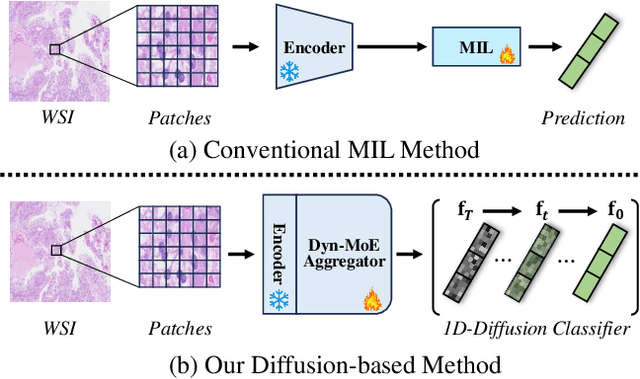
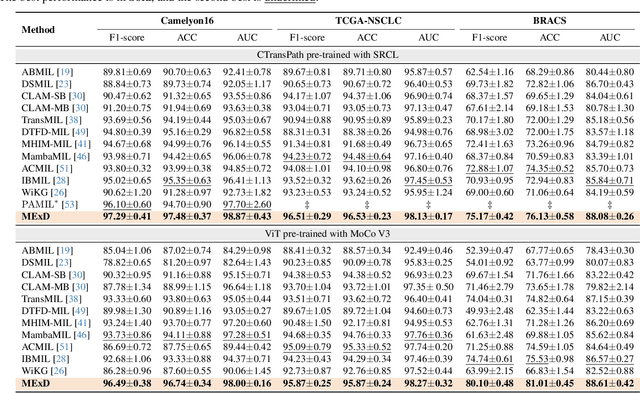
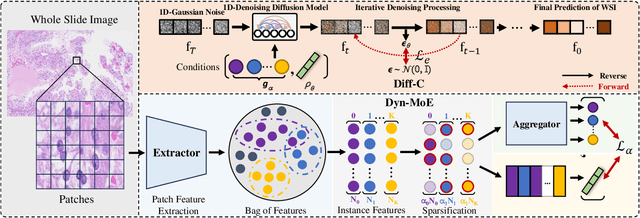
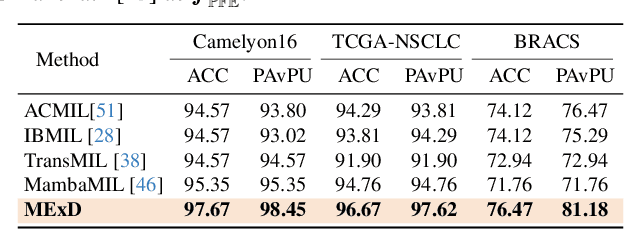
Abstract:Whole Slide Image (WSI) classification poses unique challenges due to the vast image size and numerous non-informative regions, which introduce noise and cause data imbalance during feature aggregation. To address these issues, we propose MExD, an Expert-Infused Diffusion Model that combines the strengths of a Mixture-of-Experts (MoE) mechanism with a diffusion model for enhanced classification. MExD balances patch feature distribution through a novel MoE-based aggregator that selectively emphasizes relevant information, effectively filtering noise, addressing data imbalance, and extracting essential features. These features are then integrated via a diffusion-based generative process to directly yield the class distribution for the WSI. Moving beyond conventional discriminative approaches, MExD represents the first generative strategy in WSI classification, capturing fine-grained details for robust and precise results. Our MExD is validated on three widely-used benchmarks-Camelyon16, TCGA-NSCLC, and BRACS consistently achieving state-of-the-art performance in both binary and multi-class tasks.
Measuring What Makes You Unique: Difference-Aware User Modeling for Enhancing LLM Personalization
Mar 04, 2025Abstract:Personalizing Large Language Models (LLMs) has become a critical step in facilitating their widespread application to enhance individual life experiences. In pursuit of personalization, distilling key preference information from an individual's historical data as instructional preference context to customize LLM generation has emerged as a promising direction. However, these methods face a fundamental limitation by overlooking the inter-user comparative analysis, which is essential for identifying the inter-user differences that truly shape preferences. To address this limitation, we propose Difference-aware Personalization Learning (DPL), a novel approach that emphasizes extracting inter-user differences to enhance LLM personalization. DPL strategically selects representative users for comparison and establishes a structured standard to extract meaningful, task-relevant differences for customizing LLM generation. Extensive experiments on real-world datasets demonstrate that DPL significantly enhances LLM personalization. We release our code at https://github.com/SnowCharmQ/DPL.
A Survey of Graph Transformers: Architectures, Theories and Applications
Feb 23, 2025



Abstract:Graph Transformers (GTs) have demonstrated a strong capability in modeling graph structures by addressing the intrinsic limitations of graph neural networks (GNNs), such as over-smoothing and over-squashing. Recent studies have proposed diverse architectures, enhanced explainability, and practical applications for Graph Transformers. In light of these rapid developments, we conduct a comprehensive review of Graph Transformers, covering aspects such as their architectures, theoretical foundations, and applications within this survey. We categorize the architecture of Graph Transformers according to their strategies for processing structural information, including graph tokenization, positional encoding, structure-aware attention and model ensemble. Furthermore, from the theoretical perspective, we examine the expressivity of Graph Transformers in various discussed architectures and contrast them with other advanced graph learning algorithms to discover the connections. Furthermore, we provide a summary of the practical applications where Graph Transformers have been utilized, such as molecule, protein, language, vision traffic, brain and material data. At the end of this survey, we will discuss the current challenges and prospective directions in Graph Transformers for potential future research.
EvoFlow: Evolving Diverse Agentic Workflows On The Fly
Feb 11, 2025



Abstract:The past two years have witnessed the evolution of large language model (LLM)-based multi-agent systems from labor-intensive manual design to partial automation (\textit{e.g.}, prompt engineering, communication topology) and eventually to fully automated design. However, existing agentic automation pipelines often lack LLM heterogeneity and focus on single-objective performance optimization, limiting their potential to combine weaker models for more customized and cost-effective solutions. To address this challenge, we propose EvoFlow, a niching evolutionary algorithm-based framework to automatically search a population of heterogeneous and complexity-adaptive agentic workflows, rather than a single homogeneous, complex workflow. Technically, EvoFlow performs \textit{(1) tag-based retrieval} to extract parent workflows from an agentic population, evolves new workflows through \textit{(2) crossover} and \textit{(3) mutation}, and employs \textit{(4) niching-based selection} to maintain population diversity and quality. Extensive evaluations across seven benchmarks demonstrate that EvoFlow is: \textbf{(I) diverse}, evolving a population of workflows ranging from simple I/O tasks to complex multi-turn interactions; \textbf{(II) high-performing}, outperforming previous handcrafted and automated workflows by $1.23\%\sim29.86\%$; \textbf{(III) economical}, surpassing powerful \llmname{o1-preview} at $12.4\%$ of its inference cost using weaker open-source models.
A Comprehensive Analysis on LLM-based Node Classification Algorithms
Feb 02, 2025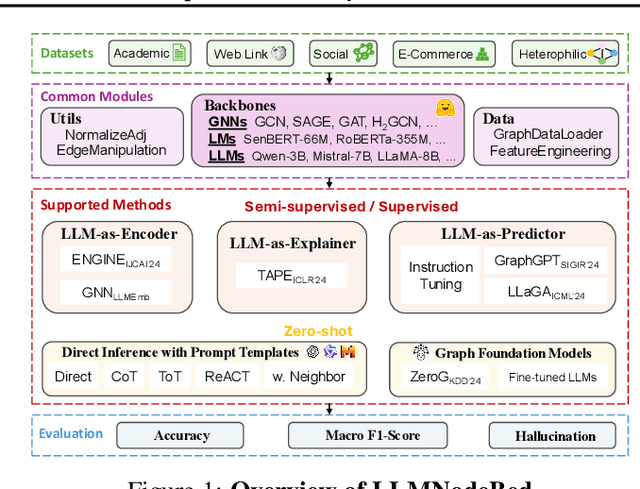
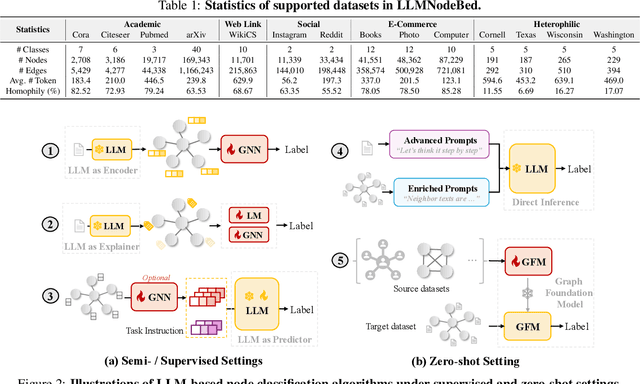
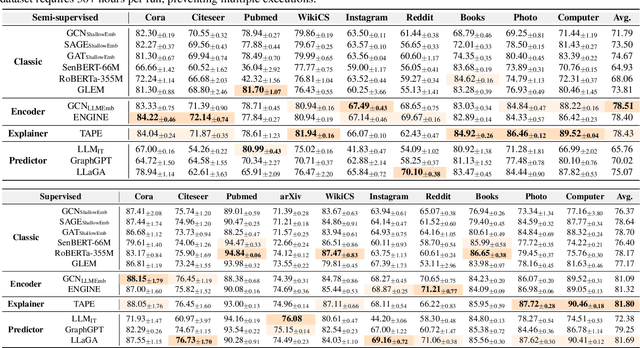
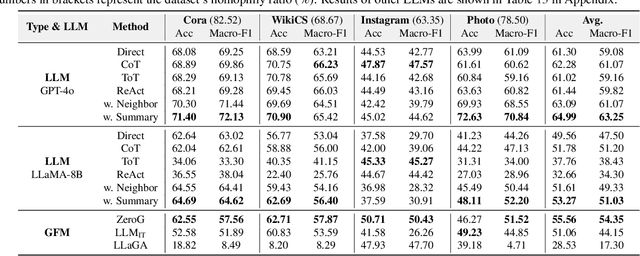
Abstract:Node classification is a fundamental task in graph analysis, with broad applications across various fields. Recent breakthroughs in Large Language Models (LLMs) have enabled LLM-based approaches for this task. Although many studies demonstrate the impressive performance of LLM-based methods, the lack of clear design guidelines may hinder their practical application. In this work, we aim to establish such guidelines through a fair and systematic comparison of these algorithms. As a first step, we developed LLMNodeBed, a comprehensive codebase and testbed for node classification using LLMs. It includes ten datasets, eight LLM-based algorithms, and three learning paradigms, and is designed for easy extension with new methods and datasets. Subsequently, we conducted extensive experiments, training and evaluating over 2,200 models, to determine the key settings (e.g., learning paradigms and homophily) and components (e.g., model size) that affect performance. Our findings uncover eight insights, e.g., (1) LLM-based methods can significantly outperform traditional methods in a semi-supervised setting, while the advantage is marginal in a supervised setting; (2) Graph Foundation Models can beat open-source LLMs but still fall short of strong LLMs like GPT-4o in a zero-shot setting. We hope that the release of LLMNodeBed, along with our insights, will facilitate reproducible research and inspire future studies in this field. Codes and datasets are released at \href{https://llmnodebed.github.io/}{https://llmnodebed.github.io/}.
Natural Language-Assisted Multi-modal Medication Recommendation
Jan 13, 2025Abstract:Combinatorial medication recommendation(CMR) is a fundamental task of healthcare, which offers opportunities for clinical physicians to provide more precise prescriptions for patients with intricate health conditions, particularly in the scenarios of long-term medical care. Previous research efforts have sought to extract meaningful information from electronic health records (EHRs) to facilitate combinatorial medication recommendations. Existing learning-based approaches further consider the chemical structures of medications, but ignore the textual medication descriptions in which the functionalities are clearly described. Furthermore, the textual knowledge derived from the EHRs of patients remains largely underutilized. To address these issues, we introduce the Natural Language-Assisted Multi-modal Medication Recommendation(NLA-MMR), a multi-modal alignment framework designed to learn knowledge from the patient view and medication view jointly. Specifically, NLA-MMR formulates CMR as an alignment problem from patient and medication modalities. In this vein, we employ pretrained language models(PLMs) to extract in-domain knowledge regarding patients and medications, serving as the foundational representation for both modalities. In the medication modality, we exploit both chemical structures and textual descriptions to create medication representations. In the patient modality, we generate the patient representations based on textual descriptions of diagnosis, procedure, and symptom. Extensive experiments conducted on three publicly accessible datasets demonstrate that NLA-MMR achieves new state-of-the-art performance, with a notable average improvement of 4.72% in Jaccard score. Our source code is publicly available on https://github.com/jtan1102/NLA-MMR_CIKM_2024.
* 10 pages
Efficient Multi-modal Large Language Models via Visual Token Grouping
Nov 26, 2024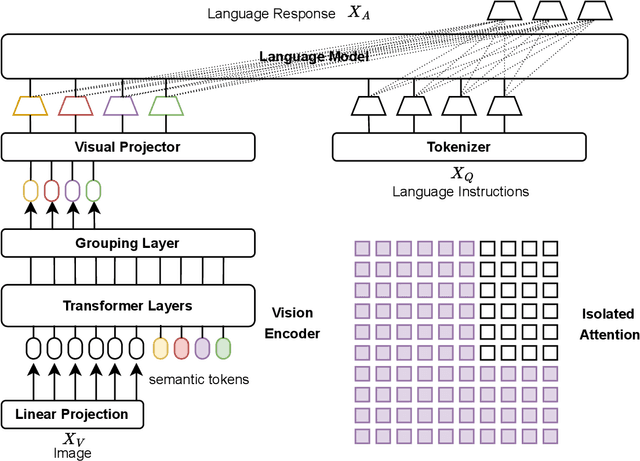
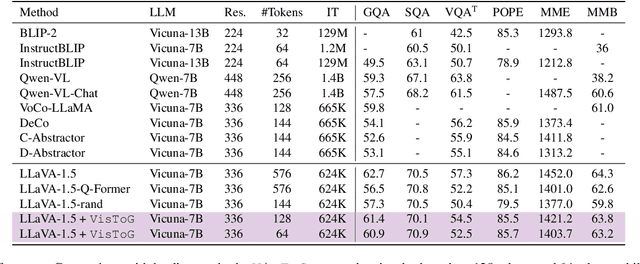
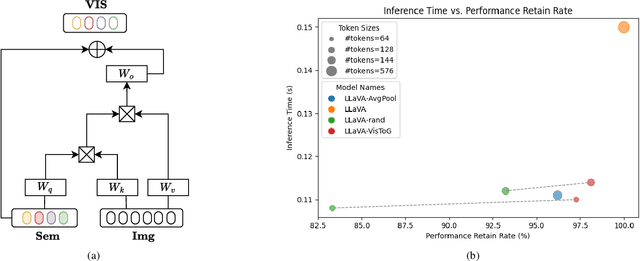

Abstract:The development of Multi-modal Large Language Models (MLLMs) enhances Large Language Models (LLMs) with the ability to perceive data formats beyond text, significantly advancing a range of downstream applications, such as visual question answering and image captioning. However, the substantial computational costs associated with processing high-resolution images and videos pose a barrier to their broader adoption. To address this challenge, compressing vision tokens in MLLMs has emerged as a promising approach to reduce inference costs. While existing methods conduct token reduction in the feature alignment phase. In this paper, we introduce VisToG, a novel grouping mechanism that leverages the capabilities of pre-trained vision encoders to group similar image segments without the need for segmentation masks. Specifically, we concatenate semantic tokens to represent image semantic segments after the linear projection layer before feeding into the vision encoder. Besides, with the isolated attention we adopt, VisToG can identify and eliminate redundant visual tokens utilizing the prior knowledge in the pre-trained vision encoder, which effectively reduces computational demands. Extensive experiments demonstrate the effectiveness of VisToG, maintaining 98.1% of the original performance while achieving a reduction of over 27\% inference time.
Adaptive Coordinators and Prompts on Heterogeneous Graphs for Cross-Domain Recommendations
Oct 15, 2024



Abstract:In the online digital world, users frequently engage with diverse items across multiple domains (e.g., e-commerce platforms, streaming services, and social media networks), forming complex heterogeneous interaction graphs. Leveraging this multi-domain information can undoubtedly enhance the performance of recommendation systems by providing more comprehensive user insights and alleviating data sparsity in individual domains. However, integrating multi-domain knowledge for the cross-domain recommendation is very hard due to inherent disparities in user behavior and item characteristics and the risk of negative transfer, where irrelevant or conflicting information from the source domains adversely impacts the target domain's performance. To address these challenges, we offer HAGO, a novel framework with $\textbf{H}$eterogeneous $\textbf{A}$daptive $\textbf{G}$raph co$\textbf{O}$rdinators, which dynamically integrate multi-domain graphs into a cohesive structure by adaptively adjusting the connections between coordinators and multi-domain graph nodes, thereby enhancing beneficial inter-domain interactions while mitigating negative transfer effects. Additionally, we develop a universal multi-domain graph pre-training strategy alongside HAGO to collaboratively learn high-quality node representations across domains. To effectively transfer the learned multi-domain knowledge to the target domain, we design an effective graph prompting method, which incorporates pre-trained embeddings with learnable prompts for the recommendation task. Our framework is compatible with various graph-based models and pre-training techniques, demonstrating broad applicability and effectiveness. Further experimental results show that our solutions outperform state-of-the-art methods in multi-domain recommendation scenarios and highlight their potential for real-world applications.
 Add to Chrome
Add to Chrome Add to Firefox
Add to Firefox Add to Edge
Add to Edge